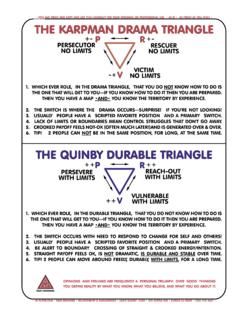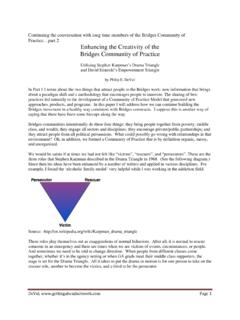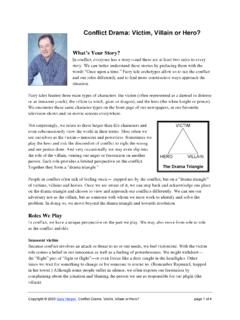Transcription of Excerpted from Healing with Language - SCS Matters
1 Excerpted from Healing with Language by Joel P. Bowman and Debra Basham The drama Triangle Preconceived Perceptual Frames (PPFs), are set at a much deeper level [than context-based perceptual frames]. For this reason, PPFs are stronger, more pervasive, and more difficult to change. People often refer to their PPFs as their issues or life scripts. PPFs are determined by what are often called archetypal patterns and karmic or past-life experiences. They may also be set by birth trauma, and other childhood trauma, especially in the first seven years of life. These PPFs are responsible for what is often called the drama Triangle, developed by Dr. Steve Karpman in 1968 ( Fairy Tales and Script drama Analysis. Transactional Analysis Bulletin, 7:26, 39-43). Archetypal Patterns. The archetypal patterns in the drama Triangle the Victim, the Persecutor (the dragon), and the Rescuer (hero) produce the principal PPFs.
2 These roles and their variants are based on energies from the lower three chakras: root, sacral, and solar plexus, and they also reflect roles developed during a child s first few months of life, when the infant is helpless and dependent on his or her parents for nurturing and survival. Core issues take form during infancy. Because that stage is both preverbal and prelocomotion, the child has only his or her emotions through which to process experience. Perceived lack seems to last forever because emotions are processed in the amygdala, a part of the brain that is fully formed at birth and the amygdala perceives everything as being in the eternal now. An infant cannot yet use Language to help understand time ( Mommy will be there in a minute ) and cannot yet conceive of space, so he or she has no way of knowing how far away a parent might be or that moving through space requires time.
3 The hippocampus, the part of the brain that places experience in a context of time and space, however, is not Joel P. Bowman and Debra Basham, Members SCS Matters , LLC The drama Triangle, Healing with Language 2 fully developed until a child is at least three or four years old. The infant perceives his or her caregivers are as good (Rescuer) or bad (Persecutor) depending on how and how quickly they meet his or her needs. Additional archetypes are the social and interpersonal roles individuals play. Most of them are ancient and reflect or include one or more of the three basic archetypal patterns. Some are based on gender (husband, wife), and some are based on function (priest, prostitute, shaman, warrior, king, queen, and fool). The following figure illustrates the drama Triangle. The drama Triangle Exacerbator Encourager Persecutor Rescuer Defuser Victim In addition to the three main players on the drama Triangle, each side of the triangle has a role that bridges between the functions.
4 The Defuser attempts to reduce the conflict between the Rescuer and the Persecutor. The Exacerbator attempts to amplify persecution and sense of victimization. The Encourager mediates between the Rescuer and the Victim, by attempting to persuade Joel P. Bowman and Debra Basham, Members SCS Matters , LLC The drama Triangle, Healing with Language 3 the individual playing the role of Victim that he or she has the resources to rescue him- or herself. Although the PPFs in the drama Triangle are interrelated, the Victim is the central role. Without a Victim, neither the Persecutor nor the Rescuer can play his or her role. Each of us develops a preference for one of the roles, and it becomes the role we play most often. We also tend to have a favorite side of the drama Triangle, and play the roles along that side more often than we do the others. All of us, however, can and do play all the roles at one time or another.
5 The Warrior, for example, may begin as a Rescuer who wants to save his or her homeland or right some terrible wrong. Because of the nature of war and battle, he or she may become a Persecutor. Finally, he or she may be betrayed and become a Victim. Past Lives. Whether you think of past lives as literal or as metaphorical, the experiences they represent, especially traumatic experiences, provide a long-lasting and pervasive influence on perceptual frames. We may, for example, have the sense of having been deceived previously, even without any actual deception in our personal history. When we read novels or see movies, we over identify with characters who are being or have been deceived. We feel as though we have been deceived. As a result of that sense, we may consistently look for evidence of deception in our current life.
6 This may be in interpersonal relationships, in business, or in more global contexts and may even involve extensive conspiracy theories. Birth Trauma. Whatever happens to the developing fetus, to a child during the birth process, and to him or her during the first few years of life can also greatly influence his or her PPF. Also, because children are born dependent and helpless, they are imprinted with the roles from the drama Triangle early in life, seeing themselves as victims and their parents or other care providers as persecutors or rescuers, depending on when and how their needs are being met. Based as it is on archetypal patterns, past life experiences, and birth trauma, the drama Triangle is with us from birth. Childhood perceptions tend to be either/or: something is either good or bad. Joel P. Bowman and Debra Basham, Members SCS Matters , LLC The drama Triangle, Healing with Language 4 Experiences through childhood and adolescence solidify those roles.
7 During early childhood in particular, the infant has neither Language nor movement to facilitate interaction with the external environment, and he or she processes all sensory data as feelings only. Because time seems to stand still during feeling states, these early experiences are amplified by seeming to last an eternity. From the infant s perspective, he or she cries forever before someone comes to help. Once children begin to develop Language and the ability to move, they begin developing a sense of time and the ability to make conscious choices about how best to solve problems, which leads to the development of the Cognitive Triangle. The Cognitive Triangle In addition to the drama Triangle, which is ruled by the lower three chakras, we also have a Cognitive Triangle, which is ruled by the upper three chakras: throat, brow, and crown.
8 The upper triangle is fueled by energy from the Imagination, just as the lower triangle is fueled by energy from the Victim. The Cognitive Triangle is not totally separate from the drama Triangle. Those playing roles on the drama Triangle are not without cognition, and those on the Cognitive Triangle are not completely free from the fears and desires that drive behavior on the drama Triangle. The move from the one to the other is gradual. We learn to be more cognitive over time. Even so, just when we are feeling proud of how rational and cognitive we have become, a PPF will assert itself, and we ll drop instantly into one of the roles on the drama Triangle. The following figure illustrates the Cognitive Triangle. Joel P. Bowman and Debra Basham, Members SCS Matters , LLC The drama Triangle, Healing with Language 5 The Cognitive Triangle Assumer Proclaimer Imagination Authority/Law Knowledge Scholar/Priest Imagination is the source of the ideas that provide the energy for the Cognitive Triangle.
9 When imagination leads to investigation and discovery, it becomes Knowledge. When it leads to rules, it becomes Law. As is true with the drama Triangle, the three principal roles on the Cognitive Triangle have intermediary roles that bridge the characteristics of the others. The Proclaimer combines legalistic or religious Authority with Imagination and becomes the voice of the Prophet Who Knows All. The Assumer combines Imagination and Knowledge, while presupposing that his or her knowledge is not subject to deletions, distortions, or unwarranted generalization. The Assumer believes that his or her mental map is a completely accurate representation of the territory. The Scholar/Priest combines Authority and Knowledge and lives by the letter of the law rather than the spirit or intent of the law. The cognitive triangle begins to develop early in childhood, starting when a child is about 7 years old, and matures along with the individual, roughly corresponding with the development of the sacral and solar plexus chakras.
10 The hippocampus has Joel P. Bowman and Debra Basham, Members SCS Matters , LLC The drama Triangle, Healing with Language 6 developed by this point and provides the individual with more information based on context, allowing him or her to see a broader perspective. In addition to good and bad, black and white, the individual is beginning to see shades of gray. Most individuals, however, remain motivated primarily by the dynamics of the drama Triangle, because those issues are so deeply rooted. Also, the roles on the upper triangle support and reinforce the roles on the lower triangle. Authority, for example, reinforces both the Persecutor and the Rescuer, and a person bridging between the lower triangle and the upper triangle from a position of Authority, plays the role of Enforcer. A person bridging between the upper triangle and the lower triangle from the position of Knowledge, plays the role of Savior.









